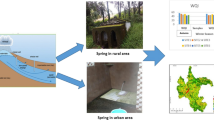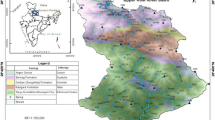Abstract
The sustainability of spring water resources requires complete basin-wide water evaluations. Spring is an essential component of groundwater resources and shows a substantial role in strengthening the socioeconomic status of the rural population. Spring is an easily available groundwater resource in parts of the Himalayan and Western Ghats region, but it was lacking proper attention from the scientific community and administrations. In recent years, the significance of springs as a vital water supply resource has gained recognition, particularly within the headwater catchments of diverse river basins. Within these areas, ensuring a sustainable water supply has emerged as a significant societal challenge. Sustainability is the key factor that requires detailed hydrological and hydro-chemical investigations. Therefore in the current study, spring inventory work has been carried out in parts of the Western Ghats. A systematic study on selected springs was carried out; therefore, 25 samples were collected in pre-monsoon (PRM) and post-monsoon (POM) seasons for 2019. Parameters like TH, TDS, Ca2+, Mg2+, and HCO3− were found within the limit according to World Health Organization (WHO) drinking water standards. Permeability index (PI), percent sodium (%Na), and sodium adsorption ratio (SAR) indices indicate the suitability of irrigation water. All samples have come within the excellent category of United States Salinity Laboratory (USSL) diagrams, which indicates zero pollution. The values of the Water Quality Index (WQI) in the study area differ from 11.2 to 24.61 and fall in excellent quality. Overall, the study shows that spring water is suitable for drinking and irrigation. The study outcomes offer consistent evidence for water resource managers to prepare maintainable and more accurate basin management policies.










Similar content being viewed by others
Data availability
On reasonable request data will be provided.
References
APHA (2005) Methods for the examination of water and wastewater. American Public Health Association
Abbasnia A, Yousefi N, Mahvi AH, Nabizadeh R, Radfard M, Yousefi M, Alimohammadi M (2019) Evaluation of groundwater quality using water quality index and its suitability for assessing water for drinking and irrigation purposes: case study of Sistan and Baluchistan province (Iran). Hum Ecol Risk Assess 25(4):988–1005. https://doi.org/10.1080/10807039.2018.1458596
Adimalla N, Dhakate R, Kasarla A, Taloor AK (2020) Appraisal of groundwater quality for drinking and irrigation purposes in Central Telangana, India. Groundw Sustain Dev 10:100334. https://doi.org/10.1016/j.gsd.2020.100334
Aravinthasamy P, Karunanidhi D, Subramani T, Roy PD (2021) Demarcation of groundwater quality domains using GIS for best agricultural practices in the drought-prone Shanmuganadhi River basin of South India. Environ Sci Pollut Res 28(15):18423–18435. https://doi.org/10.1007/s11356-020-08518-5
Brindha K, Elango L (2012) Groundwater quality zonation in a shallow weathered rock aquifer using GIS. Geo-Spatial Inf Sci 15(2):95–104. https://doi.org/10.1080/10095020.2012.714655
Brindha K, Rajesh R, Murugan R, Elango L (2011) Fluoride contamination in groundwater in parts of Nalgonda District, Andhra Pradesh, India. Environ Monit Assess 172:481–492. https://doi.org/10.1007/s10661-010-1348-0
Brown RM, McClelland NI, Deininger RA, O’Connor MF (1972) A water quality index—Crashing the psychological barrier. Indic Environ Qual. https://doi.org/10.1007/978-1-4684-2856-8_15
Doneen L (1964) Notes on water quality in agriculture. Published as Water Science and Engineering Paper 4001, Department
Duraisamy S, Govindhaswamy V, Duraisamy K, Krishinaraj S, Balasubramanian A, Thirumalaisamy S (2019) Hydrogeochemical characterization and evaluation of groundwater quality in Kangayam taluk, Tirupur district, Tamil Nadu, India, using GIS techniques. Environ Geochem Health 41(2):851–873. https://doi.org/10.1007/s10653-018-0183-z
Eaton E (1950) Significance of carbonate in irrigation water. Soil Sci 69:123–133
Egbueri JC, Ameh PD, Ezugwu CK, Onwuka OS (2022) Evaluating the environmental risk and suitability of hand-dug wells for drinking purposes: a rural case study from Nigeria. Int J Environ Anal Chem 102(17):5528–5548. https://doi.org/10.1080/03067319.2020.1800000
Elçi A, Polat R (2011) Assessment of the statistical significance of seasonal groundwater quality change in a karstic aquifer system near Izmir-Turkey. Environ Monit Assess 172(1–4):445–462. https://doi.org/10.1007/s10661-010-1346-2
Fenta MC, Anteneh ZL, Szanyi J, Walker D (2020) Hydrogeological framework of the volcanic aquifers and groundwater quality in Dangila Town and the surrounding area, Northwest Ethiopia. Groundw Sustain Dev. https://doi.org/10.1016/j.gsd.2020.100408
Gibbs RJ (1970) Mechanisms controlling world water chemistry. Science 170(3962):1088–1090. https://doi.org/10.1126/science.170.3962.1088
Helsel DR, Hirsch RM (2002) Statistical methods in water resources. US Geological Survey. https://pubs.usgs.gov/of/2008/1370/
Kadam AK, Umrikar BN, Sankhua RN (2020) Assessment of recharge potential zones for groundwater development and management using geospatial and MCDA technologies in the semiarid region of Western India. SN Appl Sci 2(2).https://doi.org/10.1007/s42452-020-2079-7
Kanagaraj G, Elango L, Sridhar SGD, Gowrisankar G (2018) Hydrogeochemical processes and influence of seawater intrusion in coastal aquifers south of Chennai, Tamil Nadu, India. Environ Sci Pollut Res 25(9):8989–9011. https://doi.org/10.1007/s11356-017-0910-5
Kelly W (1963) Use of saline irrigation water. Soil Sci 95(4):355–339
Kumar S, Shirke KD, Pawar NJ (2008) GIS-based colour composites and overlays to delineate heavy metal contamination zones in the shallow alluvial aquifers, Ankaleshwar industrial estate, south Gujarat, India. Environ Geol 54(1):117–129. https://doi.org/10.1007/s00254-007-0799-2
Mukate SV, Panaskar DB, Wagh VM, Baker SJ (2020) Understanding the influence of industrial and agricultural land uses on groundwater quality in semiarid region of Solapur, India. Environ Dev Sustain. https://doi.org/10.1007/s10668-019-00342-3
Murkute YA (2014) Hydrogeochemical characterization and quality assessment of groundwater around Umrer coal mine area Nagpur District, Maharashtra, India. Environ Earth Sci 72(10):4059–4073. https://doi.org/10.1007/s12665-014-3295-5
Nagaiah E, Sonkamble S, Mondal NC, Ahmed S (2017) Natural zeolites enhance groundwater quality: evidences from Deccan basalts in India. Environ Earth Sci. https://doi.org/10.1007/s12665-017-6873-5
Noori AR, Singh SK (2023) Assessment of seasonal groundwater quality variation employing GIS and statistical approaches in Kabul basin, Afghanistan. Environ Dev Sustain. https://doi.org/10.1007/s10668-022-02876-5
Paliwal KV (1972) Irrigation with saline water. In: Monogram no. 2 (new series). IARI, New Delhi, p 198
Panaskar DB, Wagh VM, Muley AA, Mukate SV, Pawar RS, Aamalawar ML (2016) Evaluating groundwater suitability for the domestic, irrigation, and industrial purposes in Nanded Tehsil, Maharashtra, India, using GIS and statistics. Arab J Geosci. https://doi.org/10.1007/s12517-016-2641-1
Pawar NJ, Pawar JB, Kumar S, Supekar A (2008) Geochemical eccentricity of ground water allied to weathering of basalts from the deccan volcanic province, India: insinuation on CO2 consumption. Aquat Geochem 14(1):41–71. https://doi.org/10.1007/s10498-007-9025-9
Piper AM (1944) A graphic procedure in the geochemical interpretation of water-analyses. Trans Am Geophys Union 25(6):914. https://doi.org/10.1029/TR025i006p00914
Ravikumar P, Somashekar RK, Angami M (2011) Hydrochemistry and evaluation of groundwater suitability for irrigation and drinking purposes in the Markandeya River basin, Belgaum District, Karnataka State, India. Environ Monit Assess 173(1–4):459–487. https://doi.org/10.1007/s10661-010-1399-2
Rawat KS, Singh SK, Gautam SK (2018) Assessment of groundwater quality for irrigation use: a peninsular case study. Appl Water Sci 8(8):1–24. https://doi.org/10.1007/s13201-018-0866-8
Reddy SKK, Gupta H, Reddy DV, Kumar D (2021) The suitability of surface waters from small west-flowing rivers for drinking, irrigation, and aquatic life from a global biodiversity hotspot (Western Ghats, India). Environ Sci Pollut Res 28(29):38613–38628. https://doi.org/10.1007/s11356-021-13154-8
Richards LA (US Salinity laboratory) (1954) Diagnosis and improvement of saline and alkaline soils. In: US Department of Agriculture hand book. pp 60
Sabale R, Jose M (2022) Optimization of conjunctive use of surface and groundwater by using LINGO and PSO in water resources management. Innov Infrastruct Solut 7(1):1–10. https://doi.org/10.1007/s41062-022-00750-x
Salehi S, Chizari M, Sadighi H, Bijani M (2018) Evaluation des utilisateurs des eaux souterraines pour l’agriculture en Iran: un biais environnemental culturel. Hydrogeol J 26(1):285–295. https://doi.org/10.1007/s10040-017-1634-9
Schoeller H (1977) Geochemistry of groundwater. In groundwater studies—an international guide for research and practice. Ch. 15 edn, pp 1–18
Selvakumar S, Chandrasekar N, Kumar G (2017) Hydrogeochemical characteristics and groundwater contamination in the rapid urban development areas of Coimbatore, India. Water Resour Ind 17(September):26–33. https://doi.org/10.1016/j.wri.2017.02.002
Singh SK, Noori AR (2022) Groundwater quality assessment and modeling utilizing water quality index and GIS in Kabul Basin, Afghanistan. Environ Monit Assess 194(10):673. https://doi.org/10.1007/s10661-022-10340-0
Shankar BS, Raman S (2020) A novel approach for the formulation of Modified Water Quality Index and its application for groundwater quality appraisal and grading. Hum Ecol Risk Asses Int J 26(10):2812–2823. https://doi.org/10.1080/10807039.2019.1688638
Srinivas Y, Aghil TB, Hudson Oliver D, Nithya Nair C, Chandrasekar N (2017) Hydrochemical characteristics and quality assessment of groundwater along the Manavalakurichi coast, Tamil Nadu, India. Appl Water Sci 7(3):1429–1438. https://doi.org/10.1007/s13201-015-0325-8
Subba Rao N, Chaudhary M (2019) Hydrogeochemical processes regulating the spatial distribution of groundwater contamination, using pollution index of groundwater (PIG) and hierarchical cluster analysis (HCA): a case study. Groundw Sustain Dev 9:100238. https://doi.org/10.1016/j.gsd.2019.100238
Wagh V, Panaskar D, Muley A, Mukate S, Gaikwad S (2018) Neural network modelling for nitrate concentration in groundwater of Kadava River basin, Nashik, Maharashtra, India. Groundw Sustain Dev 7:436–445. https://doi.org/10.1016/j.gsd.2017.12.012
WHO (2011) Guidelines for drinking water quality, Library Cataloguing-in-PublicationData, 4th ed. WA 675. Geneva, World Health Organization
Wilcox L (1955) Classification and use of irrigation waters. USDA Circular No. 969
Wilcox LV (1948) The quality of water for irrigation use. U.S. Department of Agriculture, Technical Bulletin 962 (40). U.S. Department of Agriculture, Washington
Wu J, Sun Z (2016) Evaluation of shallow groundwater contamination and associated human health risk in an alluvial plain impacted by agricultural and industrial activities. Mid-west China Expos Health 8(3):311–329. https://doi.org/10.1007/s12403-015-0170-x
Acknowledgements
The authors wish to thank the Head of the Department of National Institute of Hydrology Belagavi, Karnataka, for provided necessary facilities to carry out the present research also, my guide Dr B K Purandara for constant support and guidelines. The authors are grateful to editor and anonyms reviewers for their constructive suggestions and comments, which help to strengthen the manuscript.
Author information
Authors and Affiliations
Corresponding author
Ethics declarations
Conflict of interest
The authors declare that they have no competing interests.
Ethical approval
The study was carried out in a genuinely authentic manner, and the experiments conducted using standard procedures.
Informed consent
For this type of study consent is not required.
Rights and permissions
Springer Nature or its licensor (e.g. a society or other partner) holds exclusive rights to this article under a publishing agreement with the author(s) or other rightsholder(s); author self-archiving of the accepted manuscript version of this article is solely governed by the terms of such publishing agreement and applicable law.
About this article
Cite this article
Utagi, U.N., Purandara, B.K. Tempo-spatial quality assessment of spring water using WQI and GIS modeling in Western Ghats region of India. Innov. Infrastruct. Solut. 8, 302 (2023). https://doi.org/10.1007/s41062-023-01275-7
Received:
Accepted:
Published:
DOI: https://doi.org/10.1007/s41062-023-01275-7




